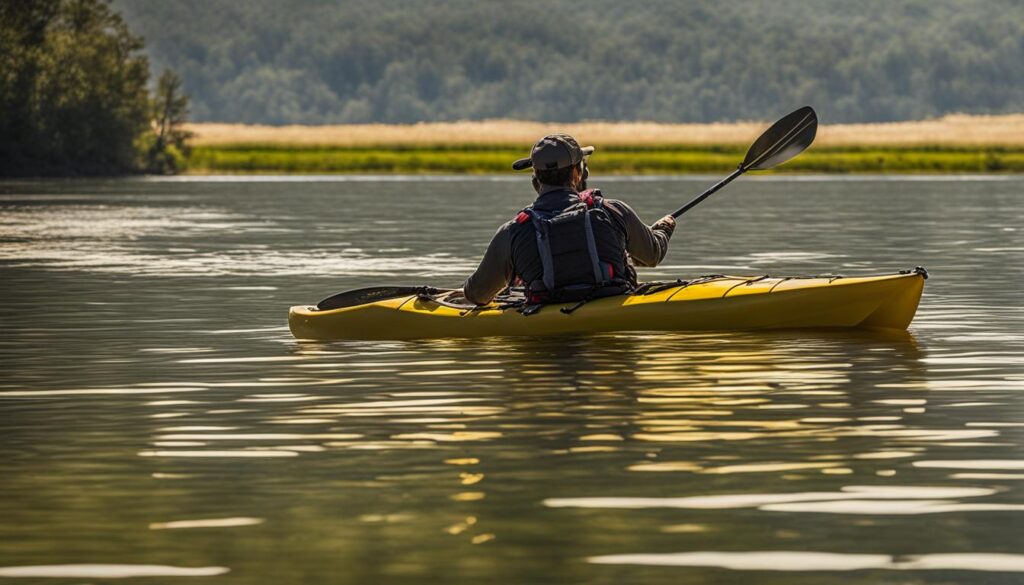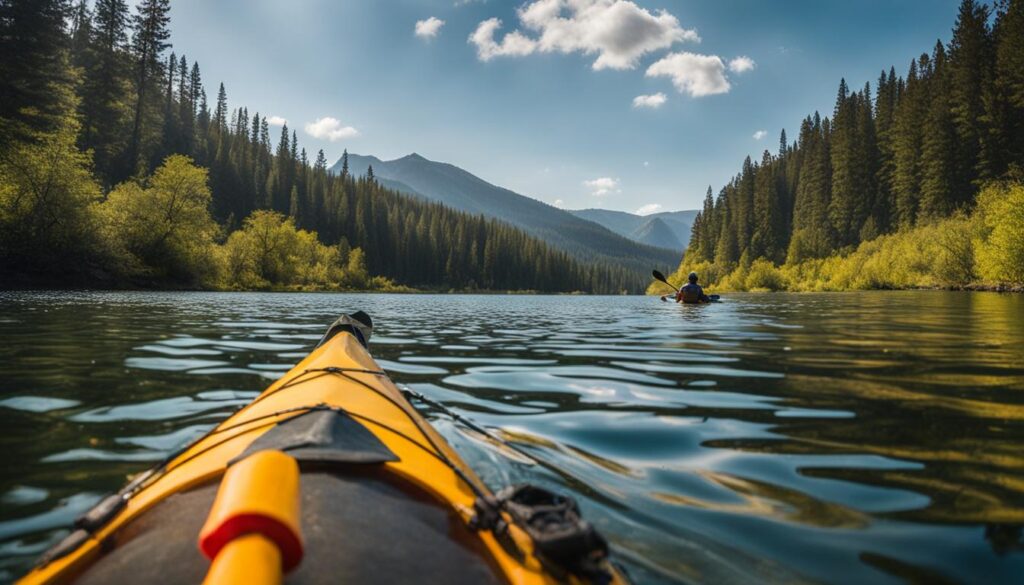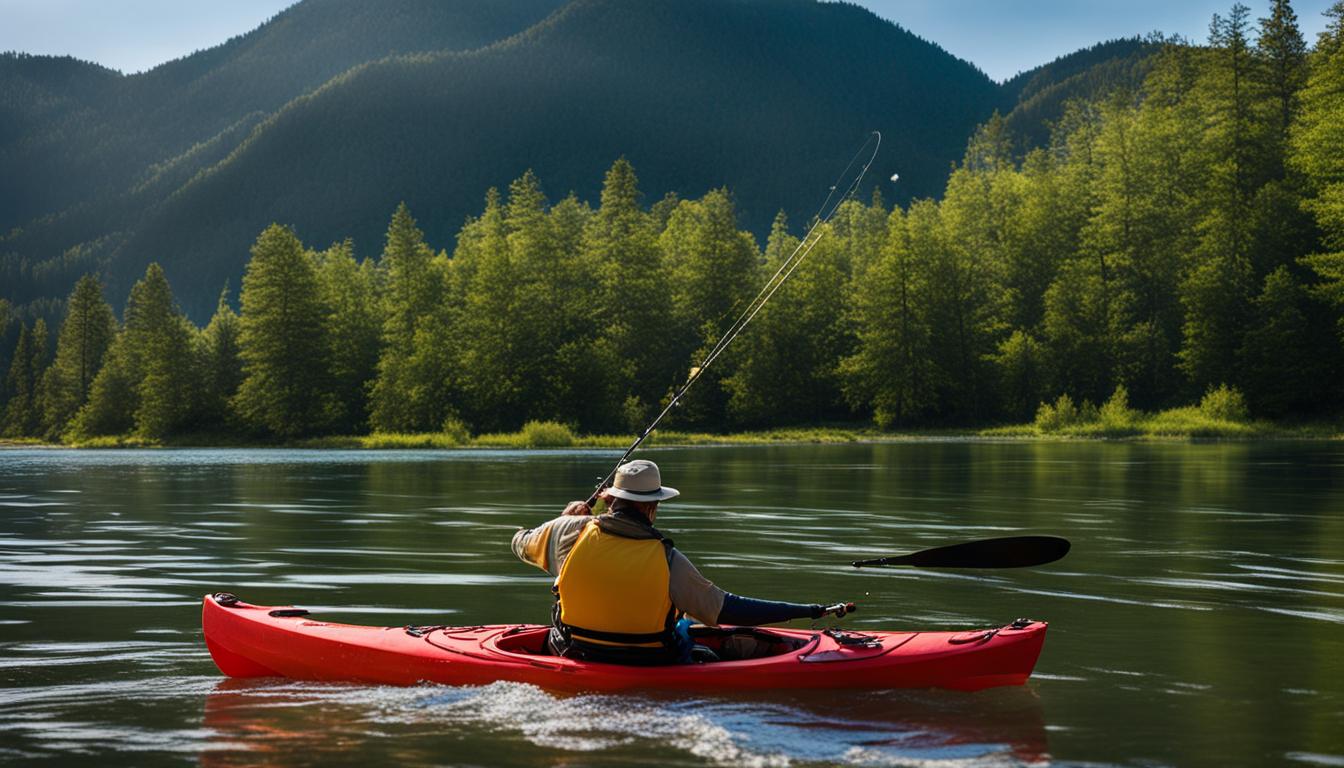Kayak fishing offers a unique and exciting way to connect with nature while pursuing your passion for angling. However, to truly excel as a kayak angler, you need to master the specific techniques and tips that are essential for success in this exhilarating sport.
In this article, we will explore advanced kayak casting and retrieval techniques that will enhance your skills on the water. From flip casting to utilizing your feet as rudders, these techniques will take your kayak fishing abilities to the next level.
But before we dive into the details, let’s understand the importance of mastering these techniques and the impact they can have on your kayak angling experience.
Key Takeaways:
- Mastering advanced kayak casting and retrieval techniques can greatly improve your kayak fishing experience.
- Flipping, shooting, and pitching techniques allow you to reach under or near structures over the water’s edge.
- Using your feet as rudders can help you navigate and steer your kayak more efficiently on waterways.
- Eddies and proper kayak anchoring techniques can maximize your fishing opportunities.
- Always prioritize safety when practicing advanced kayak fishing techniques.
Flipping, Shooting, and Pitching: Mastering the Art of Flip Casting
When it comes to kayak fishing, mastering advanced casting techniques is crucial for success. One such technique is flip casting, which allows you to get your lure under or near structures over the water’s edge. By leveraging the power of a slingshot-like motion, you can reach those hard-to-access spots and increase your chances of catching fish.
Flipping is a technique where you drop line from the end of your rod, grab the lure with your free hand, and create a bent rod. This motion propels the lure under cover, giving you an advantage in targeting fish hiding in dense vegetation or submerged structures. The key is to make a short, accurate cast without disturbing the surrounding area.
Shooting is a more dynamic technique that involves extending your rod parallel to the water’s surface and releasing the line with a quick flick of your wrist. This technique allows you to cover larger distances and reach targets that are farther away. It’s particularly useful when you need to cast over obstacles or make long-range presentations.
Pitching is a finesse technique that combines elements of flipping and shooting. It involves a smooth, controlled motion where you lift the lure from a low position and release it with a flick of the wrist, similar to shooting. Pitching is ideal for precise presentations and is commonly used when targeting specific areas, such as isolated cover or structure.
“Mastering the art of flip casting can greatly enhance your kayak fishing experience. It gives you the ability to access hard-to-reach spots and increase your chances of catching fish. With practice, you’ll become more proficient in flipping, shooting, and pitching, allowing you to adapt to various fishing scenarios and elevate your angling skills.” – Experienced Kayak Angler
Fishing Techniques Comparison Table
| Technique | Description | Advantages |
|---|---|---|
| Flipping | Releasing line from the rod’s end to get the lure under cover. |
|
| Shooting | Extending the rod parallel to the water and releasing the line with a flick of the wrist. |
|
| Pitching | A smooth, controlled motion of lifting and releasing the lure with a flick of the wrist. |
|

Mastering these flip casting techniques takes practice and patience. It’s essential to understand the specific scenarios where each technique shines and adapt accordingly. By incorporating flip casting into your fishing repertoire, you’ll be equipped with versatile skills that enable you to navigate challenging fishing environments and increase your chances of landing that prized catch.
Mastering the One-Handed Paddle for Efficient Kayak Angling
Efficient kayak angling requires skill in handling a paddle with one hand. Whether you need to free up your other hand for fighting a fish or simply want to maneuver your kayak more effectively, mastering the one-handed paddle technique is essential.
To execute the one-handed paddle technique, start by locking the shaft of your paddle along your forearm. This creates an anchor point, allowing you to maintain control and stability while steering with just one hand. By using this technique, you’ll be able to make subtle adjustments to your kayak’s direction without sacrificing your ability to reel in a catch.
Practicing the one-handed paddle technique is especially crucial in situations where you need simultaneous control of your fishing rod and kayak. For instance, if you find yourself battling a feisty fish that’s determined to take you for a ride, being able to steer with one hand can mean the difference between landing a trophy catch and losing it.
“Mastering the one-handed paddle technique has completely transformed my kayak angling experience. It gives me the confidence and control I need to navigate tight spots and keep my rod in the action while reeling in fish. It’s a game-changer for any serious kayak angler.” – Experienced Kayak Angler
Benefits of the One-Handed Paddle Technique:
- Enhanced maneuverability and control
- Ability to steer while fighting a fish
- Improved responsiveness in tight or confined spaces
- Increased efficiency when adjusting your kayak’s position
| Technique | Advantages |
|---|---|
| One-Handed Paddle | Improved control and maneuverability, ability to steer while fighting a fish |
| Two-Handed Paddle | Greater power and stability for longer paddling distances |
Mastering the one-handed paddle technique is a valuable skill that every kayak angler should strive to develop. With practice and persistence, you’ll be able to navigate challenging fishing spots with ease and finesse, increasing your chances of landing your next big catch.
Using Your Feet as Rudders and Casting to Steer Your Kayak
When it comes to controlling your kayak on the water, experienced anglers have discovered a clever technique that allows them to use their feet as rudders. By using this technique, you can effectively steer your kayak’s drift and maintain stability while focusing on your fishing. Let’s take a closer look at how you can use your feet as rudders and casting to steer your kayak.
Using your feet as rudders works by utilizing the natural movements of your legs to control the direction of your kayak. You can simply push one foot against the inside of the hull to create resistance, causing your kayak to turn in that direction. This technique is especially useful when you need to make quick adjustments or keep your kayak in position while casting or reeling in a fish.
Using Your Feet as Rudders: Step-by-Step Guide
- Position yourself comfortably in the kayak with your legs slightly bent.
- Place one foot against the inside of the hull on the side you want to turn.
- Apply pressure with your foot to create resistance against the water.
- Feel the kayak change direction as you steer with your foot.
- Release the pressure when you want to straighten your kayak’s drift.
In addition to using your feet as rudders, casting to steer is another effective technique for controlling your kayak. By casting your lure in specific directions, you can subtly adjust your boat’s position and navigate through different fishing spots with precision. This technique is particularly useful when you want to maneuver your kayak around obstacles or position yourself for a better casting angle.
“Casting to steer is like having a secret weapon in your kayak angling arsenal. It allows you to make small adjustments to your kayak’s position without the need for paddling, giving you more time to focus on fishing.”
Remember, mastering the art of using your feet as rudders and casting to steer takes practice. The more you use these techniques, the more natural and intuitive they will become. So, the next time you head out on the water in your kayak, give these kayak control techniques a try, and experience a new level of control and precision in your angling adventures.

Maximizing the Benefits of Eddies and Proper Kayak Anchoring
When it comes to kayak fishing, understanding how to make the most of your surroundings can greatly enhance your fishing experience. Utilizing eddies is a valuable skill that can help you improve your chances of success on the water. Eddies are areas of calm water that form behind obstacles, such as rocks or fallen trees, creating a current break. By positioning your kayak in an eddy, you can stay in one place, allowing you to focus on fishing in the current seam where fish are likely to gather.
Proper kayak anchoring techniques are also crucial for maximizing your kayak fishing opportunities. Anchoring can be particularly useful in windy areas or offshore spots where you want to maintain your position. By securely anchoring your kayak, you can cast your line with precision and ensure that you’re fishing in the most productive areas. However, it’s important to exercise caution when anchoring in strong currents to avoid potential dangers. Always assess the current and adjust your anchoring strategy accordingly.
By mastering the use of eddies and employing proper kayak anchoring techniques, you can significantly improve your chances of success while kayak fishing. These techniques allow you to effectively position yourself and increase your access to prime fishing spots. So, next time you’re out on the water, don’t overlook the advantages of eddies and strategic anchoring – they can make all the difference in maximizing your kayak fishing experience.
FAQ
What are some advanced casting techniques used in kayak fishing?
Advanced casting techniques in kayak fishing include flipping, shooting, and pitching. These techniques allow you to get your lure under or near structures over the water’s edge.
How do I perform flipping, shooting, and pitching techniques?
To perform these techniques, you need to turn your rod into a slingshot by dropping line from the end of your rod, grabbing the lure with your free hand, and creating a bent rod. This helps you get further under cover and reach hard-to-reach spots.
How can I efficiently handle a paddle with one hand while kayak angling?
Practice locking the shaft of your paddle along your forearm to anchor it, allowing for easier one-handed steering. This technique is especially useful when you’re fighting a fish with one hand and need to steer your kayak at the same time.
Can I use my feet to steer my kayak?
Yes, experienced kayak anglers often use their feet as rudders to steer their kayak’s drift on waterways. Using your feet as anchors can help you stay in place when fishing near logs or shallow areas. Additionally, certain baits like crankbaits, spinnerbaits, and chatterbaits can be used to steer the boat and adjust your position subtly.
How can I maximize the benefits of eddies and proper kayak anchoring?
Eddies can be helpful when kayak fishing if you know how to use them to your advantage. Many lightweight kayaks can sit entirely in an eddy, preventing them from moving downstream and allowing you to fish the current seam. Anchoring also has its place in kayak fishing, especially in windy areas or offshore spots where you want to stay in one specific area. However, be cautious when anchoring in strong currents to avoid potential dangers.





